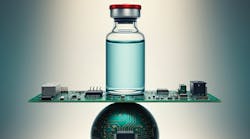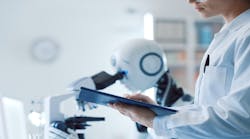We are no longer strangers to the impact of digital technology. Since the mid-20th century, digitization has had a tremendous impact on the way we consume, exchange, analyze and use information. Today, another wave of digital transformation is washing over industries across sectors from retail to life sciences in the form of automation and advanced analytics, and it’s enabling efficiencies and growth at an unprecedented scale. In fact, the International Data Corporation (IDC) predicts that 40% of the total revenue for Global 2000 organizations will be generated by digital products, services and experiences by 2026. For the pharmaceutical industry, adopting digital solutions throughout the value chain can have a profound impact on patients, as it allows companies to rapidly develop and commercialize lifesaving therapies and quickly get them to those who need them most. From streamlining workflows to reducing human errors to uncovering new insights through predictive models that can guide decision making, there are a plethora of benefits from leaning into next-generation technologies to bridge the gap between teams, across organizations or in a lab full of analytical instruments.
Supporting modern scientists
According to McKinsey Life Science and Data Analytics’ Digital Maturity Index, life science leaders have trailed behind cross-industry leaders in digital adoption, but those that have implemented comprehensive digital solutions saw a 15% bottom line improvement in the following five years. As the scientific world continues to rapidly evolve, there is an increased demand for technological solutions that can streamline workflows and accelerate scientific discovery. For organizations looking to revolutionize the way that scientific research is conducted, it is necessary to incorporate digital solutions so that the once-manual laboratory processes can be optimized through data connectivity and automation.
For modern scientists, connecting instruments — regardless of vendor — and data is paramount. This connectivity allows for easier knowledge sharing with data flowing from each point in the workflow, and not only does that offer efficiency benefits, but it can enable scientists to rapidly conduct experiments when there is an urgent need to scale up. For example, during the race for a vaccine at the beginning of the COVID-19 pandemic, pharma companies relied on technology transfer to speed vaccines from development to manufacturing to commercialization. Since then, pharma companies have been investing in creating interconnected operations to ensure that they can meet an influx of demand. During global health emergencies and in the day-to-day for pharmaceutical scientists, data is the backbone of drug development. When digital solutions are implemented across organizations, they can connect instruments, reconcile software and integrate lab components that lead to harmonious processes and workflows and enable better data collection for more informed decision making. When incorporating these solutions, it’s important to consider technologies that can support the entire life cycle of the highly regulated pharma industry, while simultaneously offering the flexibility scientists require to adapt for scientific discovery.
Building the lab of the future
There are several promfinent digital technologies that can have a robust impact on highly matrixed pharma organizations and offer additional value when they are incorporated in tandem as building blocks for labs of the future. Many labs use cloud-based platforms that both centralize data and incorporate computational systems that can process data for storage and retrieval, such as Laboratory Information Management Systems (LIMS) or electronic lab notebooks (ELN). However, pharma leaders are increasingly turning to technologies that can also help reduce manual tasks, which subsequently lowers the risk of human errors throughout the lab, increases productivity and lowers costs. These technologies include the Internet of Laboratory Things (IoLT), artificial intelligence (AI), machine learning (ML) and automation systems. Often referred to as smart solutions, AI/ML can be used for holistic lab management from equipment maintenance or troubleshooting networked systems to guiding decision making with ML algorithms. AL/ML can also be used for predictive analysis in experimentation so that scientists can uncover new ways of interrogating the data and extract the maximum amount of information from their data to propel scientific research. For example, in drug discovery, AI can be incorporated to help scientists identify potential drug candidates which, in turn, allows the scientists to prioritize the most promising drug targets and design their experiments accordingly. In pharma manufacturing workflows, AL/ML can also be instrumental for quality control which can accelerate the development process and speed-to-clinic. On the more physical equipment side, automated systems, such as robotics, not only improve workflows and experimentation through reproducibility and streamlined sample preparation, but they also enable both novice and experienced scientists to focus more of their time on conducting experiments that advance scientific understanding. Connecting next-gen technologies throughout the lab creates a comprehensive ecosystem that enables innovation. From increased productivity to maximizing the value of data and improved communication, organizations that institute a digital strategy can reap significant benefits and, ultimately, further scientific discovery.
Accelerating the pace of scientific breakthroughs
Accelerating the drug discovery and development process can play a significant role in making our world healthier and safer. From small molecule drug development to advanced therapies, the pharma industry can lean on digital technologies to create therapies that improve patient outcomes for hard-to-treat diseases. When large amounts of data are generated in pharma R&D, scientists can rely on digital tools to help them parse through results quickly and efficiently. For example, advanced technologies and lab automation have been able to accelerate genetic analysis to the point where individual genes can be sequenced quickly and affordably. According to the National Human Genome Research Institute, some genetic sequencing labs can now sequence over 100,000 billion bases per year, and an entire genome can be sequenced for just a few thousand dollars. This allows scientists to mass compare DNA sequences, which can provide critical insights about genetic disease traits to inform diagnostic and therapeutic research. With these novel technologies, scientists can explore new areas of disease research and create innovation at scale. Digitization and lab automation can also contribute to cross-modality studies as we collectively work toward the ability to personalize treatments with precision medicine.
Overcoming challenges of adoption
In the pharma industry, digital transformation can help get lifesaving therapies to patients as quickly as possible. However, according to McKinsey, digital transformations are often more difficult to achieve than traditional change management even though the long-term benefits far outweigh the cost. Pharma leaders must rethink operating models across a diverse scope of applications, which poses a challenge to adoption. Regulatory bodies must also assess new methodologies and create guidelines for new technology use while prioritizing safety. Creating a connected lab can pose both technological challenges and people challenges. In some instances, the existing lab software may prevent the adoption of automated solutions, or the infrastructure prevents scientists from accessing insights across the lab. There are also concerns about maintaining legacy technologies as new solutions come online and time spent training scientists to use new systems. The first step in a digital transformation across an organization is to evaluate the current challenges and set goals for creating a connected ecosystem. Pharma companies need to invest in adopting digital and smart solutions to ensure that they can prioritize innovation, reduce R&D costs, streamline end-to-end workflows, speed manufacturing and holistically address patient needs. Impact of a digital ecosystem According to Deloitte, there is industry-wide interest in adopting next-generation technologies — from AI to robotics — to help scientists do more science, and organizations are planning digital transformation strategies to create labs of the future.
Automated science can be transformative for modern research and drug development by enhancing efficiency and throughput, reducing human error and enabling scientists to conduct experiments on an unprecedented scale. Modern scientists need technological solutions that alleviate data silos and extract the maximum amount of value to accelerate the pace of scientific discovery with less time spent analyzing the data and more time spent on experimentation. Digital solutions and automation can also aid in making science more accessible, driving breakthroughs and contributing to the overall success of the industry. As the pharma industry continues to embrace digital transformation, the link between scientists at the bench and a healthier, safer and cleaner world grows stronger. And while there are clear benefits for creating a digital ecosystem, industry leaders must work to overcome the challenges of adoption and strategically collaborate with technology providers to take the first step from scope to implementation. Investing in lab automation can help digitally-enabled scientists unlock scientific possibilities and advance understanding in a way that will be life-changing for patients.






